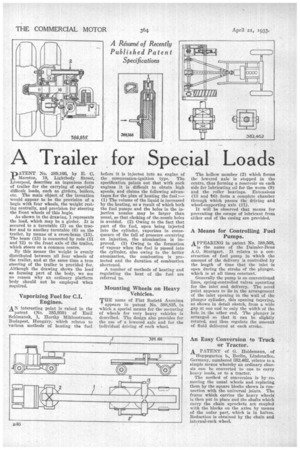A Trailer for Special Loads
Page 60

If you've noticed an error in this article please click here to report it so we can fix it.
"nATENT No. 389,166, by E. C.
Marston, 19, Lightbody Street, Liverpool, describes an ingenious form of trailer for the carrying of specially difficult loads, such as girders, boilers, etc. The main object of the invention would appear to be the provision of a bogie with four wheels, the weight resting centrally, and provision for steering the front wheels of this bogie.
As shown in the drawing, 1 represents the load, which may be a girder. It is secured to a turntable (2) on the treeitor and to another turntable (6) on the trailer, by means of a cross-beam (13). The beam (13) is connected by rods (11 and 12) to the front axle of the trailer, which steers on a common centre.
By this means the weight is evenly distributed between all four wheels of the trailer, and at the same time a true steering of the trailer is provided for. Although the drawing shows the load as forming part of the body, we see no reason why an ordinary platform body should not be employed when required.
Vaporizing Fuel for C.I.
' Engines.
AN interesting point is raised in the
patent (No. 385,959) of Emil Schimanek, 1, Horthy Miklosstrasse, Budapest, Hungary, which relates to various methods of heating the fuel
before it is injected into an engine of the compression-ignition type. The specification points out that with such engines it is difficult to obtain high speeds, and claims the following advantages for the plan of heating the fuel (1) The volume of the liquid is increased by the heating, as a result of which both the fuel pumps and the holes in the injection nozzles may be larger than usual, so that choking of the.nozzle holes is avoided. (2) Owing to the fact that part of the fuel, upon being injected into the cylinder, vaporizes in consequence of the fall of pressure occurring on injection, the atomization is improved. (3) Owing to the formation of vapour when the fuel is passed into the cylinder, also owing to the better atomization, the combustion is promoted and the duration of combustion shortened.
A number of methods of heating and regulating the heat of the fuel are referred to.
Mounting Wheels on Heavy Vehicles.
THE name of Fiat Societa Anonima -appears in patent No. 388,835, in which a special means for the mounting of wheels for very heavy vehicles is described. The design also provides for the use of a lowered axle and for the individual driving of each wheel.
The hollow member (2) which forms the lowered axle is stopped in the centre, thus forming a reservoir on each side for lubricating oil for the worm (9) and the roller bearings. Extensions (13 and 16) form a complete chamber through which passes the driving ail& wheel-supporting axle (11).
It will be observed that means for preventing the escape of lubricant from either end of the casing are provided.
A Means for Controlling Fuel Pumps.
AyPEARING in patent No. 388,568,
is the name of the Daimler-Benz A . G . Stuttgart. It relates to a construction of fuel pump in which the amount of the delivery is controlled by the length of time that the inlet is open during the stroke of the plunger. which is at all times constant.
Generally the pump is on conventional lines, spring-controlled valves operating for the inlet and delivery. The novel point appears to lie in the arrangement of the inlet opening in the wall of the plunger cylinder, this opening tapering, as shown in detail sketch, from a wide gap at one end to only the width of the hole in the other end. The plunger is arranged so that it can be slightly rotated, and thus regulate the amount of fluid delivered at each stroke.
An Easy Conversion to Truck or Tractor.
A PATENT of G. Ueidemann, of
Hoppegarten b., Berlin, Lindenallee. Germany, numbered 382,462, relates to a simple means whereby an ordinary chassis can be converted to one to carry heavy loads, or to a tractor.
The method of conversion is by re, moving the usual wheels and replacing them by the square blocks shown in connection with the universal joints. The frame which carries the heavy wheels is then put in place and the shafts which carry the chain sprockets are coupled with the blocks on the axles by means of the outer part, which is in halves. Reduction is obtained by the chain and internal-rack wheel.




























































































